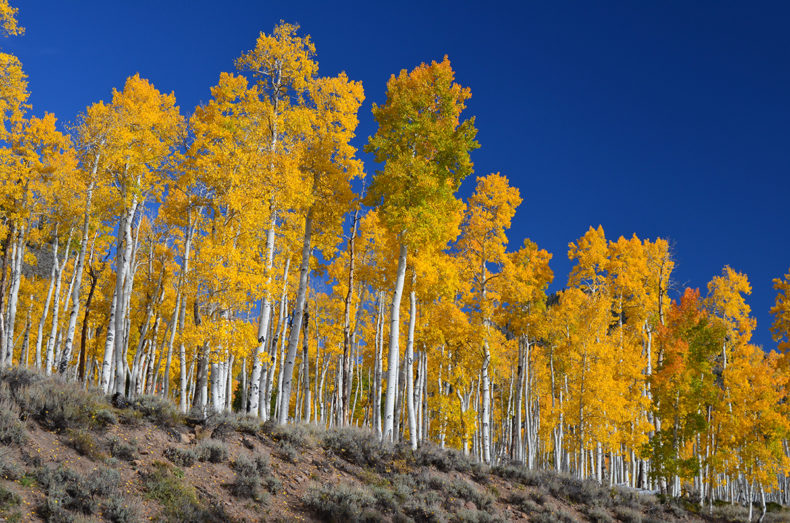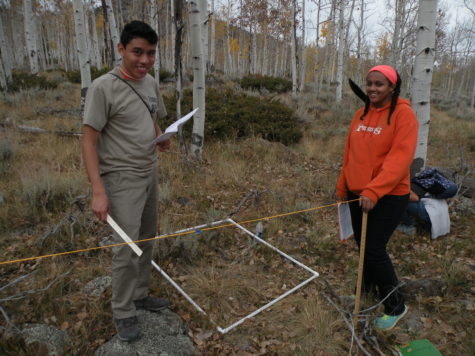 On the western edge of the Colorado Plateau, in the mountains of central Utah, is a tree that weighs an estimated 13 million pounds—as much as three giant sequoias, or 55 blue whales, or 10,000 grizzly bears. (Hey, I just thought you might like to imagine a pile of 10,000 bears.) This tree is the most massive living organism in the world, according to most of the people who argue about such things, and while estimates of its age have varied wildly, from a few hundred years to more than a million, it certainly predates any of us. Some twenty years ago, a trio of Colorado scientists nicknamed it Pando, Latin for “I spread,” and the name has stuck.
On the western edge of the Colorado Plateau, in the mountains of central Utah, is a tree that weighs an estimated 13 million pounds—as much as three giant sequoias, or 55 blue whales, or 10,000 grizzly bears. (Hey, I just thought you might like to imagine a pile of 10,000 bears.) This tree is the most massive living organism in the world, according to most of the people who argue about such things, and while estimates of its age have varied wildly, from a few hundred years to more than a million, it certainly predates any of us. Some twenty years ago, a trio of Colorado scientists nicknamed it Pando, Latin for “I spread,” and the name has stuck.
Pando, which is a quaking aspen, doesn’t look like a single tree. Like many plant species but only a few trees, aspen usually reproduce asexually, by sending out horizontal roots which then sprout new stems. Over its long lifetime, Pando has sprouted around 47,000 genetically identical stems from a single root system, creating one organism that covers more than 100 acres. Quaking aspen do occasionally reproduce sexually, and each clone’s flowers are either all male or all female. Pando, as it happens, is a boy. One 13-million-pound boy tree.
Pando, however, is in trouble. For years, perhaps decades, very few of its new stems have been reaching adulthood. “To put it in human terms, there’s a missing generation,” says Paul Rogers, director of the Western Aspen Alliance and a professor at Utah State University. Because aspen do tend to thrive in places with frequent wildfires, some people thought Pando would benefit from a controlled burn. Others thought that selective logging of its stems, or clearing of the shrubs around them, would stimulate new growth. Others thought new stems were being eaten by deer, elk, or cattle, and still others thought Pando was simply reacting to the region’s rising average temperatures and worsening drought.
Rogers and his team tested these theories, alone and in combination, on a 15-acre area of Pando, surveying the clone’s responses to different treatments over a three-year period. The results were refreshingly simple: the most effective cure for Pando’s malaise was a fence. Burning, cutting, and clearing didn’t hurt, but they weren’t needed to encourage new growth—and without the help of a fence sturdy enough to keep out both deer and cattle, they didn’t work at all.
Pando, surveying the clone’s responses to different treatments over a three-year period. The results were refreshingly simple: the most effective cure for Pando’s malaise was a fence. Burning, cutting, and clearing didn’t hurt, but they weren’t needed to encourage new growth—and without the help of a fence sturdy enough to keep out both deer and cattle, they didn’t work at all.
Pando isn’t alone in its troubles: throughout western North America, aspen have been showing various signs of decline, and often struggling to reproduce. While it’s possible to fence off a single tree, even a uniquely gigantic one, not every aspen in the region can be physically protected from hungry browsers and grazers. The damage is likely to hit harder and linger longer in coming years, especially as heat and drought stress increase with climate change.
What’s being lost? Well, beauty, for one. Quaking aspen groves, with their cool white trunks and bright-yellow, fluttering fall foliage, are among the most gorgeous places in a famously scenic region. Throughout North America and the rest of the Northern Hemisphere, aspen stands are also remarkable oases of biodiversity, and many species depend on them for survival.
While the results of Rogers’ study are encouraging in their simplicity, the long-term solution to aspen decline is far more complicated. In the western U.S., state wildlife agencies like to keep deer and elk numbers high, because more game means more successful hunters, more dollars in state coffers, and, often, more satisfaction within the politically-appointed boards that oversee the agencies. Reducing the region’s artificially enormous herds would go a long way toward protecting aspen forests that can’t be fenced, but the obstacles to doing so are deeply political, economic, and cultural. Keeping cattle out of places where they may stunt aspen growth is a similarly complex challenge.
In the decades since its christening, Pando has become a symbol of persistence and renewal: it’s a tourist attraction in its own right, and its name has been borrowed by both an ecological conference and a tech media company. For Rogers, the clone’s slow but increasingly visible desistance is a sign of larger human failings. “When something that’s so big, and has been around so long, just starts to fall apart,” he says, “that points the finger back at us.”
Top: Pando clone photo by J. Zapell. Courtesy Fishlake National Forest.
Bottom: Students from Utah’s Ogden High School International Baccalaureate program conduct vegetation surveys at Pando. Courtesy Paul Rogers.
More wolves, please.